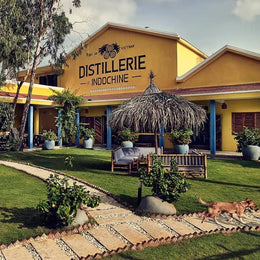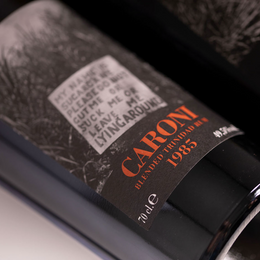
Rum has fast become one of the most exciting domains the past decade because of how the scene remains a hotbed for novel and highly unique interpretations of the terroir of most anywhere in the world, as well as at the same time being quite the canvas for creativity and experimentation that often leads to exciting (and tasty) outcomes. Consequently, from time to time, the rum world gets rumblings of something special making its emergence - this time it seems that all eyes are drawn to... Taiwan?
Now Taiwan is known for many things, yet somewhat peculiarly rum is not one of them. Even though sugarcane had once been a serious avenue of industry on the island, historically geopolitical reasons have disallowed the industry from gaining serious footing. Nevertheless, it is perhaps the dearth of rum that has birthed a renaissance - of rum!
The Birth Of Renaissance

Linya and Olivier, the people behind Renaissance. (Image Source: Rumporter)
Renaissance Rum and its distillery based in southern Taiwan was founded by husband and wife duo Olivier Caen and Linya Chiou - officially it was launched in 2017, but prep work for the distillery started as far back as the early 2010's when the couple would balance their days jobs, raising their kids, whilst expending serious effort to see if producing rum in Taiwan was indeed viable. Taiwan itself is home to over four hundred local varieties of sugarcane (all denoted in alphanumeric code starting with the letter F for Formosa, the Portuguese name given to Taiwan), and because of its geography, even supports producing both molasses and sugarcane juice based rums.
The couple had previously been in the auto industry but by 2006 had decided to establish a wine and spirits import business. Taking inspiration from a family friend who also happened to be a prolific winemaker in Saint-Emilion, Jean-Luc Thunevin, the couple had sought to make their mark and create something as well. As Taiwan is one of the world's largest whisky markets, and whisky as a spirit was by they time already well understood by the Taiwanese consumer, they turned their attention to rum, which had no serious presence in Taiwan, and consumer appreciation was equally non-existent.

Renaissance Rum's front label is deceptively simple by any means, turn to the back label and be wowed. (Image Source: The Whisky Exchange)
They would go about finding a pot still and would grow their own sugarcane, and begin testing with various sugarcane derivatives. Along the way, of course, things weren't easy - getting the right permits and sourcing sugar from local factories were all snags that had to be straightened out along the way. Nevertheless, the couple has been very committed that they would produce rum to the highest standard possible and pursue a goal of making the highest quality rums.
Bold Moves Befitting Of An Obsession With Relentless Quality - Will It Work; And The Call To Represent Taiwan On The Rum Stage
They've emphasised that they have no desire to focus on volume as they believe that quality would have to be compromised, and also believe that transparency and a tight control over what is represented under their banner is incredibly important. This has meant really small output numbers (according to Lance from The Lone Caner, only 17 barrels worth of production had been released up till 2020) - all single casks! And would explain that super stacked and detailed back label, as well as there being no independent bottlings or maturation taking place outside of Taiwan, everything is 100% controlled and done by Renaissance which is all then stated on that back label. But perhaps most notoriously, this seems to justify a major source of contention for rum folks about Renaissance - the incredible price on Renaissance bottles. They are pretty pricey.

Some serious back label game. (Image Source: Rumporter)
Yet ultimately no one's forced to buy it - the couple seems secure in their belief that their rums are for those who appreciate it. If you believe in what Renaissance does then paying for it seems reasonable - put your money where your mouth is! But as Lance so eloquently writes, this does make it difficult for first time folks to get acquainted with Renaissance's rums and therefore almost snuffs out the oxygen needed to grow this tinder into a global bonfire - they may be highly regarded by serious rum folks, but the combination of a hefty price tag, lack of accessibility, as well as there being no core or standard expression which makes it hard for folks to pin down what exactly is Renaissance (or more broadly, Taiwanese rums) poses a serious drag.
As Lance acutely points out, many distilleries of massive popularity today such as Hampden have laid out the more conventional route of first producing a consistent and standard workhorse that serves as the distillery's signature and often many would-be fans' first touchpoint with the distillery. While Renaissance may not have necessarily asked for such a responsibility - it ultimately dons the cape of being Taiwan's first real rum. And thus has the added duty to showcase to the world what being a Taiwanese rum means - and especially arduous task for a point of origin that till date has no real representation in the category. Therefore most in the rum community will rely on Renaissance to showcase what precisely is distinctive about Taiwan as a producer of rums. Without a (also more available) classic expression, it remains difficult for Taiwan to eke out a distinctiveness the likes of its Caribbean counterparts.
Likely if not for Renaissance's exclusive expression (it was a 2018 Fino Cask) for mega online spirits retailer The Whisky Exchange, even the majority of these hardcore rum folks might never have gotten a chance to try Renaissance's rums.

Renaissance Distillery actually has a podcast on Spotify here.
A Debut Years In The Making, And An Inordinate Obsession With Detail
Now lest it seems that Renaissance's esteem came out of the blue or happened almost spontaneously, it should be emphasised that really it has been a journey of over a decade of serious commitment to their craft (consider the 4-5 years spent simply testing the viability of producing rums in Taiwan). And while in terms of time-space continuum it's been a decade, the experimental streak embraced by the distillery mapping out the multitude of dimensions available to them should really be thought of as a multiplier of those years - it's like cramming more years into one vintage.
Of the some 400 varietals of sugarcane available in Taiwan, Renaissance uses just two - F10 and F16. They've placed fermentation times for their molasses rum to at the shortest being 10 days and at the longest being well over 20 days. For sugarcane juice rums that range is between 15 to 22 days. According to Rumporter, Linya has discussed how they've explored the effects of fermentation times against the brix sugar level in the cane juice and how that influences the profile of any particular vintage (each vintage being different) - she mentions very fascinatingly that hot weather results in higher sugar levels, while cold weather results in the sugarcane being less concentrated in sugar. Renaissance ferments each batch accordingly to these factors. She's even spoken in depth on the range of cuts for each distillation and the degree of toasting of various casks.

Fully harnessing the value of being craft and independent by embracing a more experimental streak.
Yet another factor that warrants serious thought is the high temperatures and humidity in Taiwan which results in an angel's share of as high as 14%. This requires Renaissance to take special measures to ensure their rums age properly. Taking a quick gander at Renaissance's portfolio of expressions, you'll immediately notice that the distillery likes to experiment with an incredibly diverse and wide variety of cask types - yet various types of wine barrels seem to be the most common. These casks are sourced from anywhere from France and Spain in Europe, to Russia, Japan and the US.
Another key addition to the distillery's toolkit has been their recently acquired Charentais still that is most commonly used for Cognac making. Given the distillery's rather "artisanal" highly varied and small batch production, every release being a single cask at cask strength is itself a single iteration of pretty much one full round of production by the distillery.

The Reception Thus Far; And Our Own Take
Now with all that said, it's worth capping off this little deep dive with a sense of what the rum community thinks of Renaissance - not that it should influence anyone, but is worth understanding the consensus which can serve as a benchmark for where we ourselves stand - and that is "definitely very well made, albeit alittle offbeat". Renaissance rums are without a doubt high quality - they're always full-bodied, big on flavour, cohesive and with intensity in both aromas and taste. Yet, most folks (including myself) have tended to come off thinking that the flavours encapsulated are rather unique and if we're being honest, alittle funky and sometimes highly unusual and unexpected. Its quality is of no question, but it's flavours are certainly distinctive to say the least - there's nothing quite like it in the existing rum language.

This is just half of it.
Given that every expression is pretty much a 1-of-1, that as mentioned earlier delivers the rum as authentically as possible, it nevertheless also makes comparisons difficult and pinning down a signature profile tricky - but we'll try.
Having tasted quite the extensive range at a local bar in Singapore, Samsu Huaykuan, which likely sports one of the most sizeable collections of Renaissance's rums, I've consistently found their rums to be highly umami and savoury, and my honest characterisation would be that they are alittle bit of an acquired taste simply because we don't typically consume highly umami flavours, but as we've seen with the popularity of many umami food ingredients, we do have a penchant for the flavour. In that sense, they're always very unique and interesting, but also not what you typically associate with the existing rum literature.

Taiwan's once illustrious sugarcane trade.
Remember though, the same was once said of the likes of Jamaica's ultra-funky Hampden or the intensely tarry and diesel-driven Trinidadian Caroni.
Will Renaissance be yet another rum aficionado's cliche of having missed the boat? The jury is still out, but we'll find out pretty soon.
Special thanks to Lance from The Lone Caner and The Rumporter for their research into Renaissance.
Kanpai!

@111hotpot




